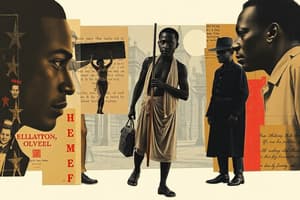Podcast
Questions and Answers
What was the main issue regarding loans in the past, as described in the text?
What was the main issue regarding loans in the past, as described in the text?
- Borrowers were not condemned to a life of toil
- Debts were easily paid off, and children did not have to pay after the parent's death
- There was an excess of usury, which hindered baptism and confession (correct)
- There was a lack of usury, which hindered baptism and confession
What happened if the husband did not punish the adulterer when his wife had a child?
What happened if the husband did not punish the adulterer when his wife had a child?
- The woman was punished, but the child still inherited
- The child was not considered the husband's and did not inherit anything (correct)
- The child was considered the husband's and inherited equally with any other children
- The child was punished along with the adulterer
What was the impact of the punishment of the adulterer by the husband?
What was the impact of the punishment of the adulterer by the husband?
- The offender was considered dishonored, and the husband left the woman
- The offender was not considered dishonored, and the husband left the woman
- The offender was considered dishonored, but the husband did not leave the woman
- The offender was not considered dishonored, and the husband did not leave the woman (correct)
How were children treated in terms of inheritance if the adulterer was punished by the husband?
How were children treated in terms of inheritance if the adulterer was punished by the husband?
What was the impact of the husband's punishment of the adulterer on the child's legitimacy?
What was the impact of the husband's punishment of the adulterer on the child's legitimacy?
What was the status of borrowers in the traditional system described in the text?
What was the status of borrowers in the traditional system described in the text?
What was the punishment for a free woman who had children by a slave?
What was the punishment for a free woman who had children by a slave?
If two persons married, one a maharlica and the other a slave, how were the children divided?
If two persons married, one a maharlica and the other a slave, how were the children divided?
What happened if a slave-woman had children by the slave of another master?
What happened if a slave-woman had children by the slave of another master?
What was the status of a child born to a free woman and a slave?
What was the status of a child born to a free woman and a slave?
If a slave had children by the slave of another master, what happened to the child?
If a slave had children by the slave of another master, what happened to the child?
What was the status of a child born to a maharlica and a slave?
What was the status of a child born to a maharlica and a slave?
What type of slaves could be sold?
What type of slaves could be sold?
How were namamahay slaves and their children transferred?
How were namamahay slaves and their children transferred?
What happened to the children and accomplices of witches?
What happened to the children and accomplices of witches?
How were offenses punished, other than witchcraft?
How were offenses punished, other than witchcraft?
What happened if a culprit could not pay the fine promptly?
What happened if a culprit could not pay the fine promptly?
How were the earnings from a slave's labor divided between the master and the slave?
How were the earnings from a slave's labor divided between the master and the slave?
Flashcards are hidden until you start studying




